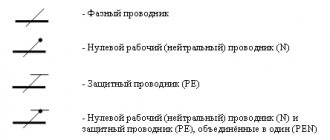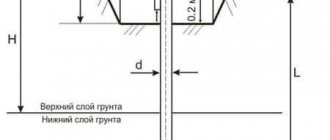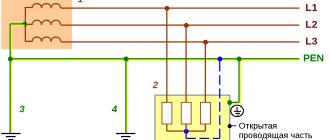Protection against direct contact
To protect a person from direct contact, there are two main protective measures.
1. The first one is quite logical. To protect a living being from touching live parts, it is necessary, but not sufficient, to physically cover those live parts. For example, electrical wires are protected with insulation, exposed live parts are fenced, etc. 2. Second protection, additional from direct contact. It must protect a person who has already touched a live part. This protection is based on the use of a residual current device (RCD) in the electrical network, with a short response time and high sensitivity (no more than 30 mA).
What is indirect touch?
This term means electric shock as a result of touching exposed conductive structural elements that carry a high potential as a result of an unexpected accident. That is, in a normal situation, these structural elements would not pose a danger to human life, since they would not be under the influence of electric current.
For those who prefer that the definitions of technical terms be given verbatim from regulatory documents, we will quote from the PUE (see paragraph 1.7.12).
Definition of indirect touch according to the PUE, clause 1.7.12
That is, in this case we are not talking about a double circuit, when touching occurs on two phases.
Insulation as protection against direct contact
Insulation of electrical wires, as well as their connections, is the main method of protection. All wires and cables that are used in electrical installations and are accessible to touch must have electrical sheaths (insulation) in accordance with regulatory documents.
For example, a three-core cable of the VVG brand has polyvinyl chloride core insulation and general cable insulation made of the same material.
Another example, power transmission wires mounted on poles (inaccessible for touching) may not have insulation (AB wires).
Examples of indirect touching
Let us give several examples of the touch in question, found in everyday life and at work. Let's say that an electric kettle with a metal body has damaged the insulation of the heating element. As a result, dangerous touch voltage is generated on the housing. If you take such a kettle in your hand, nothing will happen, since in this case we will be dealing with a unipolar touch.
The situation will change dramatically if you touch the mixer with your second hand, in which case an electrical circuit is formed that passes through the human body (double-pole touch). This will be equivalent to direct contact with zero and phase. The described threat can come from many household appliances, for example, a vacuum cleaner, storage water heater (boiler), washing machine, etc.
Examples of indirect touch in everyday life
A typical example in production is a breakdown of the insulation of a phase wire and its contact with the body of an electrical installation. If you simultaneously touch the metal shell of the equipment (where the breakdown occurred) and an open, current-conducting structure with zero potential, a person will be shocked. If the insulation of the neutral or protective wire is violated, the maximum that can happen is a single-phase short circuit, which leads to the disconnection of the circuit breaker.
Protection by fences and shells
This protective measure is familiar to everyone. All transformer substations, open electrical installations, electrical panels must be fenced off with fences, doors, and equipped rooms.
In addition, for the installation of all switching and protective devices of electrical circuits, so-called shells must be installed, or more simply shields, cabinets, boxes with doors.
Related articles: Assembly of Legrand input panel for 144 modules
In this case, the doors of the enclosures must be locked, and an additional screen must be installed between the doors and the live parts themselves.
It is important to note. If the shells are made of metal, they must be grounded together with the electrical installation.
All of the protective measures listed are precautionary, but from experience, they are not sufficiently reliable. There are several reasons for this:
Similar
What is the difference between direct touch and indirect touch?
The definition of both types of touches is given as in the PUE (see clause 1.7.11-12). Visual examples of both touches are given below.
Examples of touches: 1) direct; 2) indirect
As can be seen from the figure, the direct type is touching non-insulated current conductors. In most cases, this occurs due to accidental contact due to carelessness, error, or due to dangerous proximity to the electrical installations of the building. In this case, safety is ensured by preventing accidental contact with dangerous live conductors. For this purpose, special technical protection measures are provided, such as: installation of fences, warning signs, etc.
If we consider indirect touch, then it occurs only in an emergency situation when the insulation of current-carrying conductors is broken. This leads to the formation of phase potential on the installation body and the formation of dangerous zones with leakage current. To prevent contact, special measures are provided, which will be discussed below.
Website
Electric shock to a person is dangerous to the health and life of any living creature. To protect against electric shock, special protection devices are included in electrical wiring diagrams. These are differential circuit breakers, residual current devices, electrical releases, etc. Each of them is designed to protect a person from certain contacts with live parts of electrical wiring.
In electrical engineering, human contact with live wires and structures is divided into direct and indirect contact.
Direct touch
Direct touch refers to human contact with a part of the electrical wiring that is energized during operation. In other words, a person’s shaking of open wires, contacts, terminals through which electric current flows in normal (not emergency) modes is a direct touch.
There are several types of direct touch
- Touching two different phases with two hands;
- Simultaneous touching of phase and zero;
- Touching only one wire in a 2-wire network.
When two phases touch, the human body is included in the full linear voltage of the network. This is the most dangerous of all touches. With it, current flows through vital organs. For example, when touched with both hands, current flows through the heart and lungs.
The current through the human body when touching phase conductors twice is practically independent of the network neutral mode. At any neutral, the current through the human body is determined by Ohm's simple law. The current through the body is directly proportional to the line voltage and inversely proportional to human resistance.
If we take into account the human resistance of 1000 Ohms, and the network voltage is 380 Volts, then the current through the human body is 380 mA (milliamps), which is the lethal threshold of the current.
Note: The permissible time interval for current passing through the human body is 0.01 - 2 seconds. In this case, the magnitudes of currents passing through the human body are divided into five points according to the type of consequences of exposure.
Table of damage current values and its consequences for human exposure.
| Sensible current | 0.6 -1.5 mA |
| Threshold current | up to 5 mA |
| Release current | 5 -10 mA |
| Not releasing current | 10-15 mA |
| Fibrillation current (guaranteed death) | 100 mA |
Protection measures
Considering that the threat of contact is accidental, special measures are required to minimize the danger posed by electrical contact with third-party conductive elements that contain dangerous potential. The list of special measures is specified in GOSTs 50571.1-93 and 30331.1-95, we list what the regulatory documents offer:
Let us consider in more detail each of the listed protection measures.
Grounding
In this case, we are talking not about functional, but about protective grounding. That is, conductive surfaces of equipment that pose a potential danger are connected to the charger. If the insulation resistance becomes lower than permissible, and as a result, phase voltage is formed on the housing. By touching such an installation body, a person standing on the ground will be exposed to dangerous voltage equal to the potential of a single-phase current.
When all open conductive surfaces that pose a possible threat are connected to the charger, the situation described above will not occur, since the contact point will be at zero potential.
Indirect contact between ungrounded and grounded housings
As you can see, the nature of the effect of electrical touch is determined by the resistance of the circuit. In the first case, touching a conductive element leads to the passage of electric current through the human body. In the second, the grounding resistance is much lower than that of the human body, so the leakage occurs through the charger.
Electrical laboratory » Questions and answers » PUE 7th edition » 1.7.67-1.7.72. Precautions against direct contact
Precautions against direct contact
1.7.67. Basic insulation of live parts must cover the live parts and withstand all possible impacts to which it may be subjected during its operation. Removal of insulation should only be possible by destroying it. Paint and varnish coatings are not insulation that protects against electric shock, except in cases specifically specified in the technical specifications for specific products. When performing insulation during installation, it must be tested in accordance with the requirements of Chapter. 1.8. In cases where basic insulation is provided by an air gap, protection from direct contact with live parts or approaching them at a dangerous distance, including in electrical installations with voltages above 1 kV, must be provided by means of shells, fences, barriers or placement out of reach.
1.7.68. Fences and shells in electrical installations with voltages up to 1 kV must have a degree of protection of at least IP 2X, except in cases where large clearances are necessary for the normal operation of electrical equipment. Guards and shells must be securely fastened and have sufficient mechanical strength. Entering the fence or opening the shell should be possible only with the help of a special key or tool or after removing the voltage from live parts. If these conditions cannot be met, intermediate barriers with a degree of protection of at least IP 2X must be installed, the removal of which must also be possible only with the help of a special key or tool.
1.7.69. Barriers are designed to protect against accidental touching of live parts in electrical installations with voltages up to 1 kV or approaching them at a dangerous distance in electrical installations with voltages above 1 kV, but do not exclude intentional touching and approaching live parts when bypassing the barrier. Removal of barriers does not require the use of a wrench or tool, but they must be secured so that they cannot be removed inadvertently. Barriers must be made of insulating material.
1.7.70. Placement out of reach for protection from direct contact with live parts in electrical installations with voltages up to 1 kV or approaching them at a dangerous distance in electrical installations with voltages above 1 kV can be used if it is impossible to carry out the measures specified in 1.7.68-1.7.69, or their insufficiency. In this case, the distance between conductive parts accessible to simultaneous touch in electrical installations with voltages up to 1 kV must be at least 2.5 m. Within the reach zone there should be no parts that have different potentials and are accessible to simultaneous touch. In the vertical direction, the reach zone in electrical installations with voltages up to 1 kV should be 2.5 m from the surface on which people are located (Fig. 1.7.6). The indicated dimensions do not take into account the use of auxiliary equipment (for example, tools, ladders, long objects).
1.7.71. Installation of barriers and placement out of reach is only permitted in areas accessible to qualified personnel.
1.7.72. In electrical rooms of electrical installations with voltages up to 1 kV, protection from direct contact is not required if the following conditions are simultaneously met: these rooms are clearly marked and access to them is possible only with a key; it is possible to freely exit the premises without a key, even if it is locked from the outside; The minimum dimensions of service passages correspond to Ch. 4.1.
Rice. 1.7.6. Reach zone in electrical installations up to 1 kV:
S - surface on which a person can be; B—base of surface S;
— the boundary of the reach zone of live parts by the hand of a person located on the surface S; 0.75; 1.25; 2.50 m - distance from the edge of the surface S to the boundary of the reach zone










